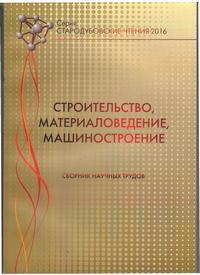Management of integration and communication by example of educational projects
Keywords:
project environment, persons which interested in the project, factors that determine the success of the project.Abstract
The work is devoted to topical issues – determine the feasibility of integrating process management in a complex dynamic environment, what is environmental education for today. The authors show that in spite of the growing foreign demand for education services, there are still a number of environmental factors negatively influencing the process. The mainconclusion is that the negative impact of external factors as significant because of the absence of an effective environment management system. One of the characteristics of quality management integration process proposed to use the indicator of the achieved level of interaction between stakeholders. The mathematical description of the proposed characteristic, appraising the current level of control and influence. Shown that the main task of the decision is to find a compromise between achievement in the desired level of control (influence) and overall organizational costs. Is a graphical model of the dynamics of the counter losses due to changes in cost and increase control of environmental factors. Shows the integral curve of the interdependence of decisions aimed at strengthening the power (influence) and reduction, as a consequence, the risk of losses from uncontrolled process. Сonclusion. Both models indicate the effectiveness of the decisions taken and can be used in the calculation and analysis of the project activities, indicating whether the decisions correct and how much from the standpoint of the interests of the existing forces that are interested in the project.
References
Bilokon A.I. and Trifonov I.V. Upravlinnia proektamy i programamy restrukturyzatsii [Project management and rehabilitation programs]. Dnipropetrovsk: PDABA, 2008, 138 p. (in Ukrainian).
Bilokon A.I., Malanchiy S.A. and Alkubalait A.D. Teoreticheskie aspekty opredeleniya i vzaimodejstviya zaitresovannykh grup lits v proektakh [Theoretical aspects of the definition and collaboration of persons groups interested in the projects]. Visnyk Prydniprovskoi derzhavnoi akademii budivnytstva ta arkhitektury [Bulletin of Pridneprovska State Academy of Civil Engineering and Archicture]. Dnipropetrovsk, 2016, no. 1, 5 p. (in Russian).
Bushuyev S.D. and Morozov V.V. Dinamicheskoe liderstvo v upravlenii proektami [Dynamic leadership in projectmanagement].Ukrainskaya assotsiatsiya upravleniya proektami [Ukrainian association of project management]. Kiev, 2000, 312 p. (in Russian).
Grashina M. and Dunkan V. Osnovy upravleniya proektami [Basics of project management]. Stankt-Peterburg: Piter, 2006, 208 p. (in Russian).
Malanchiy S.A. Upravleniya processom vzaimodejstviya stejkholderov // Theory and practice of metallurgy, № 1–2 (90–91). – Dnipropetrovsk: NMAU, 2013. – С. 186–188 (in Russian).
Walker R. Upravlenie mezhdunarodnym okruzheniem proekta [International project management environment]. Project Leadership Seminar: Confidential materials. Strategic Management Group. Philadelphia, 1994. 15 p.
Silvasti Yu. Upravlenie zainteresovanymi storonami [Management of interested parties]. Mir upravleniya proektami. Osnovy, metody, organizatsiya, primenenie [World of project management. Basics, methods organization and application]. Eds. Reschke J and Schell H. Moskva: Alans, 1993, pp. 188 – 192 (in Russian). Статья рекомендована к публикации д-ром техн. наук, В.И. Большаковым и д-ром техн. наук, Д.В. Лаухиным (Украина)
Downloads
Published
Issue
Section
License
Редакція Видання категорично засуджує прояви плагіату в статтях та вживає всіх можливих заходів для його недопущення. Плагіат розглядається як форма порушення авторських прав і наукової етики.
При виявлені у статті більш ніж 25% запозиченого тексту без відповідних посилань та використання лапок, стаття кваліфікується як така, що містить плагіат. У цьому випадку стаття більше не розглядається редакцією, а автор отримує перше попередження.
Автори, в статтях яких повторно виявлено плагіат, не зможуть публікуватися в усіх журналах Видавництва ДВНЗ «Придніпровська державна академія будівництва та архітектури».
Автори, які публікуються у цьому журналі, погоджуються з наступними умовами:
- Автори залишають за собою право на авторство своєї роботи та передають журналу право першої публікації цієї роботи на умовах ліцензії Creative Commons Attribution License, котра дозволяє іншим особам вільно розповсюджувати опубліковану роботу з обов'язковим посиланням на авторів оригінальної роботи та першу публікацію роботи у цьому журналі.
- Автори мають право укладати самостійні додаткові угоди щодо неексклюзивного розповсюдження роботи у тому вигляді, в якому вона була опублікована цим журналом (наприклад, розміщувати роботу в електронному сховищі установи або публікувати у складі монографії), за умови збереження посилання на першу публікацію роботи у цьому журналі.
- Політика журналу дозволяє і заохочує розміщення авторами в мережі Інтернет (наприклад, у сховищах установ або на особистих веб-сайтах) рукопису роботи, як до подання цього рукопису до редакції, так і під час його редакційного опрацювання, оскільки це сприяє виникненню продуктивної наукової дискусії та позитивно позначається на оперативності та динаміці цитування опублікованої роботи (див. The Effect of Open Access).

